
Top stories



“A little introspection and personal development is usually a good idea,” says Mark Raskino, Distinguished VP analyst at Gartner. “We think it is particularly valuable for CIOs because the role is changing and evolving.

Gartner developed a list of 10 resolutions for CIOs to use to reframe their thinking as they head into a new year in which business challenges could be compounded by economic headwinds.
The resolutions are divided into three groups:
CIOs should select three or four individual goals to focus on throughout 2019.
It’s easy to develop tunnel vision for defined digital goals, but don’t get blindsided by something new. To stay aware of potential new changes and technologies outside of your line of sight, attend a nontraditional technology-related event such as SXSW or CES.
It’s time to re-evaluate the initial reasoning behind your organisation’s digital initiatives. Markets and industries have shifted since many digital initiatives began. Make sure projects are still on track and being properly exploited. Remind your team to consider the business reasons for projects.
Find a technology-related area where business peers are failing to move forward, such as data science, and come up with a minimal team to demonstrate the potential of the capability to the business.
Stop talking about the IT budget and start talking about business profit and loss. CEOs associate digital growth with revenue growth, but IT is often measured on costs. Define contribution metrics, not just cost, and budget conditionally on projects.
Behavioural neuroscience, shedding light on why we do what we do, is an under-utilised area for most leaders. However, it can be a powerful tool for those looking for a cultural change. Take a class on neuroscience for executives or have your whole team attend and commit to improving the team’s brain health. Also, make time to daydream and kick into the imagination network of your brain.

Commit to a 2- or 5-day digital detox that includes a refrain from using smartphones and/or computers and tablets. For a successful detox, separate the functions of your phone into digital and nondigital versions. For example, keep a physical calendar and read printed books and newspapers. After your detox, turn off automatic phone notifications and consider device-free meetings.
Everyone has unconscious biases, which can have big impacts on talent hiring and technology use. Review job listings for words that might attract or repel candidates based on a person’s gender, ethnicity or religion. Within the company, review salary levels and promotions for opportunities to correct pay and promotion gaps.
Use language as a way to increase the power of IT and expand IT leadership. Embrace terms that reset the relationship with IT from the service provider to business partner. For example, don’t use “customer” when referring to colleagues. “CIOs are spending more time than ever presenting to the board, and they need to be effective every time,” says Tina Nunno, Distinguished VP Analyst, Gartner. Speak in the language of the C-suite by communicating in terms of the balance sheet.
Everyone has an opinion about IT, and not all of the vocal opinions will be positive. This can have a large impact on morale. CIOs should move toward a culture of positivity and pride. For example, perfection is a good goal, but acknowledging that every project has bumps in the road sets realistic expectations. Consider creating a wall of pride, a visual history of the successes and evolution of the IT department.
It’s not uncommon for CIOs to be bogged down in the day-to-day bureaucratic tasks of the job, but you should also be responsible for understanding (and potentially implementing) emerging technologies. It’s important to stay on top of both. Some emerging technologies can be simply read about, but others require designated “play” time to understand. Establish a small budget specifically for this purpose.
“The biggest internal hurdle remains how to create a more digital organisational culture,” says Mary Mesaglio, Distinguished VP Analyst, Gartner. “Be disciplined; write down specific ideas and set aside time in your calendar to make them happen. Review your progress halfway through the year, and redouble your effort.”